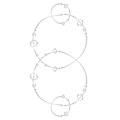In mathematics, Fatou components are components of the Fatou set. They were named after Pierre Fatou.
Rational case
If f is a rational function
defined in the extended complex plane, and if it is a nonlinear function (degree > 1)
then for a periodic component of the Fatou set, exactly one of the following holds:
- contains an attracting periodic point
- is parabolic
- is a Siegel disc: a simply connected Fatou component on which f(z) is analytically conjugate to a Euclidean rotation of the unit disc onto itself by an irrational rotation angle.
- is a Herman ring: a double connected Fatou component (an annulus) on which f(z) is analytically conjugate to a Euclidean rotation of a round annulus, again by an irrational rotation angle.
-
 Julia set (white) and Fatou set (dark red/green/blue) for with in the complex plane.
Julia set (white) and Fatou set (dark red/green/blue) for with in the complex plane.
-
 Julia set with parabolic cycle
Julia set with parabolic cycle
-
 Julia set with Siegel disc (elliptic case)
Julia set with Siegel disc (elliptic case)
-
 Julia set with Herman ring
Julia set with Herman ring
Attracting periodic point
The components of the map contain the attracting points that are the solutions to . This is because the map is the one to use for finding solutions to the equation by Newton–Raphson formula. The solutions must naturally be attracting fixed points.
-
 Dynamic plane consist of Fatou 2 superattracting period 1 basins, each has only one component.
Dynamic plane consist of Fatou 2 superattracting period 1 basins, each has only one component.
-
 Level curves and rays in superattractive case
Level curves and rays in superattractive case
-
 Julia set with superattracting cycles (hyperbolic) in the interior (period 2) and the exterior (period 1)
Julia set with superattracting cycles (hyperbolic) in the interior (period 2) and the exterior (period 1)
Herman ring
The map
and t = 0.6151732... will produce a Herman ring. It is shown by Shishikura that the degree of such map must be at least 3, as in this example.
More than one type of component
If degree d is greater than 2 then there is more than one critical point and then can be more than one type of component
-
 Herman+Parabolic
Herman+Parabolic
-
 Period 3 and 105
Period 3 and 105
-
 attracting and parabolic
attracting and parabolic
-
 period 1 and period 1
period 1 and period 1
-
 period 4 and 4 (2 attracting basins)
period 4 and 4 (2 attracting basins)
-
 two period 2 basins
two period 2 basins
Transcendental case
Baker domain
In case of transcendental functions there is another type of periodic Fatou components, called Baker domain: these are "domains on which the iterates tend to an essential singularity (not possible for polynomials and rational functions)" one example of such a function is:
Wandering domain
Transcendental maps may have wandering domains: these are Fatou components that are not eventually periodic.
See also
References
- Lennart Carleson and Theodore W. Gamelin, Complex Dynamics, Springer 1993.
- Alan F. Beardon Iteration of Rational Functions, Springer 1991.
- wikibooks : parabolic Julia sets
- Milnor, John W. (1990), Dynamics in one complex variable, arXiv:math/9201272, Bibcode:1992math......1272M
- An Introduction to Holomorphic Dynamics (with particular focus on transcendental functions)by L. Rempe
- Siegel Discs in Complex Dynamics by Tarakanta Nayak
- A transcendental family with Baker domains by Aimo Hinkkanen, Hartje Kriete and Bernd Krauskopf
- JULIA AND JOHN REVISITED by NICOLAE MIHALACHE


 of the
of the  with
with  in the complex plane.
in the complex plane.
 contain the attracting points that are the solutions to
contain the attracting points that are the solutions to  . This is because the map is the one to use for finding solutions to the equation
. This is because the map is the one to use for finding solutions to the equation 
